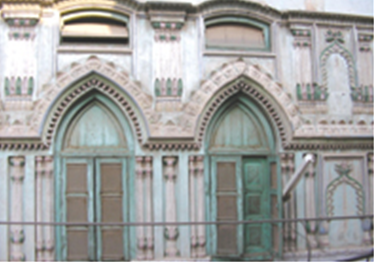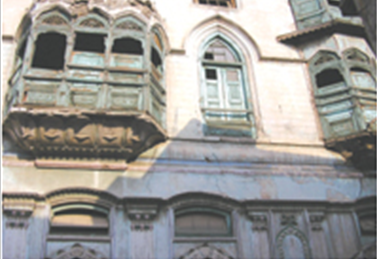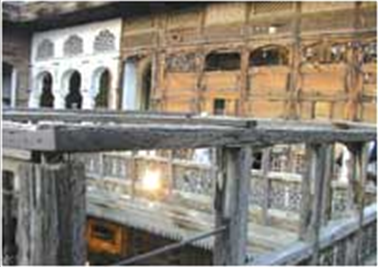Peshawar: Monuments and places
This is a collection of articles archived for the excellence of their content. Readers will be able to edit existing articles and post new articles directly |
Contents[hide] |
Peshawar
Peshawar: Islamia College
Islamia College, Peshawar: A Historic Seat Of Learning
By Sher Alam Shinwari
Any tourist, local or foreign, visiting Peshawar, must include Islamia College, Peshawar, in his/her to visit list. Located on Jamrud Road near the historic Khyber Pass, the magnificent building of Islamia College, Peshawar, (ICP) stands out proudly symbolising the grandeur of the Mughal architecture. When Bibigul, widow of Khairullah Khan of village Prang, Charsadda donated her ornaments on June 6, 1911 for college fund, she might have hoped that girls too would get benefit from this institution but unfortunately females were deprived to get education from this great seat of learning till December 2007 when the former governor Khyber-Pakhtunkhwa (old NWFP), an old Islamian, Ali Muhammad Jan Aurakzai, granted it the status of a university, where girl students were also allowed to receive education from (ICUP) for the first time in its history.
Before partition, the Edwards College in Peshawar could not cater fully to the educational needs of the poor people in the Frontier. Inspired by a visit to the Aligarh Muslim University in 1909, where some Pashtun students from the Frontier had asked Sahibzada Abdul Qayum Khan and Roos Keppel to establish either a hostel or a hall for them at Aligarh or build a quality educational institution in Peshawar so that they could be relieved of home sickness. The students also donated some money for the purpose. On return they launched a campaign for the contributions. Sethi Karim Bakhsh, a city businessman, Abdul Karim Khan and Sahibzada Abdul Qayum Khan donated Rs50,000, Rs10,000 and Rs1,000 respectively. The ruler of Dir State contributed Rs125000, in addition to 400 trees.
Several tribal elders and prominent religious scholars also donated cash money.
Renowned religious scholar and freedom fighter Maulana Fazal Wahid popularly known as Haji Sahib of Turangzai laid the foundation stone of the college mosque. The construction was started in 1911 over a land spread over 916 kanals and 17 marlas. It included an Arts college, a Daar-ul-Uloom with a hostel, a high school and three hostels, a mosque and residences for the principal and headmaster. The college opened admissions on October 1, 1913 for students to be admitted only to the first year and third year. Sahibzada Khurshid Khan a former governor of Khyber-Pakhtunkhwa (old NWFP) was the first ever student to get admission. Towards the end of the year, the number of students had reached 33. At the beginning, the college had to run with 10 faculty members, one clerk, one accountant, and two hostels namely Qayum Manzil and Hardinge.
Mr L. Tipping became the first principal while Allama Inayatullah Mashraqi was the vice principal. Sahibzada Abdul Qayum Khan, the founder of Islamia College, Peshawar used to be very careful about the academic excellence and physical beauty of the college. Sadly enough, some parts of the building are in depilated condition. The UNSECO officials during a visit to Peshawar had worked on its documentation two years ago and pledged to include the building in ‘World’s Heritage List’ but the historic seat of learning needs immediate attention for proper renovation and preservation. The college now has 12 residential hostels, lush green lawns and 160 teaching staff with around 3,000 students. It has maintained its high academic standards since its inception and will hopefully continue to do so in future.
Peshawar: Kapoor House
The Kapoor House:A Cultural Asset
By Sher Alam Shinwari
The Kapoor family, which has produced legends such as Raj Kapoor, Shammi Kapoor and Shashi Kapoor of the Indian film industry, is fondly remembered by Peshawaris. Their birthplace, ‘Kapoor family house’ still stands proudly in Dhaki Munawar Shah in Peshawar city with all its grandeur and past glory. Local and foreign tourists, especially Indian delegates love to pay visit to the magnificently built house.
Raj Kapoor house, once the tallest building — with 10 storeys — in Peshawar, is now a seven-storey structure. Its highly decorative façade is constructed with brick masonry and variety of arches, mouldings and jharokas — an essential element of typical Hindu architecture blended with Mughal structural art features. The house is in rectangular shape, spread over an area of 4625 sq. feet. It’s located in Dhaki Munawar Shah near the famous Qissa khwani bazaar and in the murky and narrow lane leading downward to Andar Shehar jewellery market. According to a wooden slab tucked inside the entrance, the construction of the house started in 1918 and completed in 1922. Consisting of 40 spacious rooms, the Raj Kapoor house has a tragic story. The owners of the historic house demolished its top three storeys some 20 years back because an earthquake had created cracks in its upper portion due to its location on steep mound, which triggered a fear among its residents that it might fall down on them. The house is surrounded by business structures, posing serious threat to its body.
The frontal portion is in shambles and the interior is also in extremely dilapidated condition due to its rough use by the tenants. Prithvi Raj’s youngest son, Shashi Kapoor and Raj Kapoor’s sons, Randhir and Rishi, came to Peshawar in 1990 and filmed their old family house. They also took some earth from here as a mark of sanctity and love for their past family abode.
After the partition when Kapoors left the house, some opportunists in the city grabbed it. Khushhal Rasool, a resident of Charsadda bought it after it was auctioned in 1968. “We had been living in the house since then. We demolished its three upper storeys as an earthquake had caused damage to it.
I shifted my family somewhere else. I want to repair and renovate it and also wish to set up a trust hospital in the Kapoor house as a tribute to the legendary family,” says Haji Muhammad Israr, a local businessman and the present owner of the Kapoor house. “If the government purchases it and tap it as a national cultural asset then it should be surely saved from another demolishing attack. The sooner steps for its preservation are taken the better it would be.”
Peshawar: Sethi House
July 19, 2008
AROUND TOWN: Sethi House: An Architectural Wonder
By Sher Alam Shinwari
Peshawar is the oldest living city of Pakistan, with 2,500-year-old history and is rich in cultural and tourist spots. It contains numerous historic sites that are lying undiscovered.
Sethis, who remained business tycoons of the Walled City till the Soviet revolution, built seven houses in Mohalla Sethian over a period of 40 years during the 19th century — the first one was constructed by Haji Ahmad Gul Sethi in 1882. Each palatial Sethi house is embellished with carved doors and wooden balconies, and is an exotic combination of brick and woodwork.
Mirrored and painted reception rooms with upper storyes to breathe fresh air presents a scintillating view. The main entrance doors are made of wood and superbly exhibits the great artisanship that has been developed over the years.
The house that the government purchased has 12 rooms and four basements and includes a fountain. Colourful glass ceilings with geometrical designs, woodwork with engravings of various splendid designs on walls, a big resting place, made of wood and called Takht-e-Sulaimani, to take sunshine in winter, beautiful ventilators, slanting window-shades, wooden wall cupboards, chimneys and red-brick stairs with projected wooden frames are some of the prominent features of the house.
The house constructed by late Karim Bakhsh Sethi is one of the seven houses that the Sethis constructed in the 1880s in the Walled City of Peshawar. The Khyber-Pakhtunkhwa (old NWFP) Archaeology and Museum Department bought the house at a cost of Rs 15 million in 2006 to preserve it as a cultural heritage and make it a tourist spot. But unfortunately renovation and repair work on the building could not be started even after a lapse of two years. The archaeology department has paid Rs1.2 million to the services and works department for hiring a consultant to renovate and repair the building, but for unknown reasons the repair work is yet to be initiated on this architectural manuscript, which is really in a shambles. The building, if not repaired and renovated, would collapse of its own weight and it would be a great negligence. The negligence might deprive Peshawar, a one time Casablanca of the East, of the remnant of its past glory.
St. John’s Cathedral
By Sher Alam Shinwari
The magnificent St. John’s Cathedral located adjacent to the Peshawar Garrison Services Club (PGSC) enjoys a novel history of its own. When the British troops entered Peshawar, after defeating the Sikh rulers in 1849, some British missionaries also came along with the occupation forces. They established a make-shift Morton Chapel in Peepal Mandi, Peshawar, while British army and their family members used to offer ‘Services’ at Company Bagh. Dr Kemp, one of the founders of the Peshawar Mission, raised funds for the construction of St. John’s Church in the Cantonment Area. The foundation stone was laid by Archdeacon Pratt, Bishop of Calcutta, on March 23, 1851.
Frederick Mackeson, the first Chief Commissioner of Peshawar stayed its construction for military reasons and also prompted Robert Clarke, Bishop of Amristar, not to come to Peshawar as he had shown interest in initiating the construction work on the Church. It is said that he swam across the Indus River at Attock Khurd and reached Peshawar in 1852. Meanwhile, Frederick Mackeson was stabbed to death in Peshawar and Sir Herbert Edwardes (1819-1868) was appointed as new Chief Commissioner of Peshawar; he withdrew stay of the construction of the proposed St. John’s Church.
Sir Herbert Edwardes had been a close friend and class-fellow of Robert Clarke, therefore, the construction was easily completed in 1860 at a cost of 11,000 British Indian rupees. Bishop Cotton of Calcutta carried out its formal consecration. Now it is run under the auspices of the Church of Pakistan (CoP). It is the property of the Diocese of Peshawar covering the entire Frontier and Northern areas founded in 1981, also responsible for giving the status of a Cathedral to the St. John’s Church in 1982.
First minor renovation was done in 1960 on its centenary celebrations, Prince Philip Duke of Edinburgh — husband of HM Queen Elizabeth II — visited the historical Church in 1961 while the next year both Philip and his wife came to Peshawar and offered services here. They appreciated the glory and grandeur associated with the beautiful building reflective of the British Missionary zeal. The Second major renovation costing Rs5 million was carried out a few years ago.
Built with clay, mud, bricks and lime in ordinary rectangular shape, the Cathedral has three main gates — southern, northern, eastern — with one small entrance westward. The tall spires of the Church lend a real monumental look to the structure from a great distance.
St. John’s Cathedral, Peshawar, is the oldest and the biggest church in the Frontier province as it can accommodate 700 people. Local Christian community actively uses this holy building for all kinds of religious and other sacred ceremonies including Christmas and New Year midnight services.
It is not only a great symbol of the Christian faith but also a rich national cultural heritage. Foreign visitors as well as locals evince equal interest upon their visit to the simple but sacred building in its unique architectural magnificence and serene environment.







